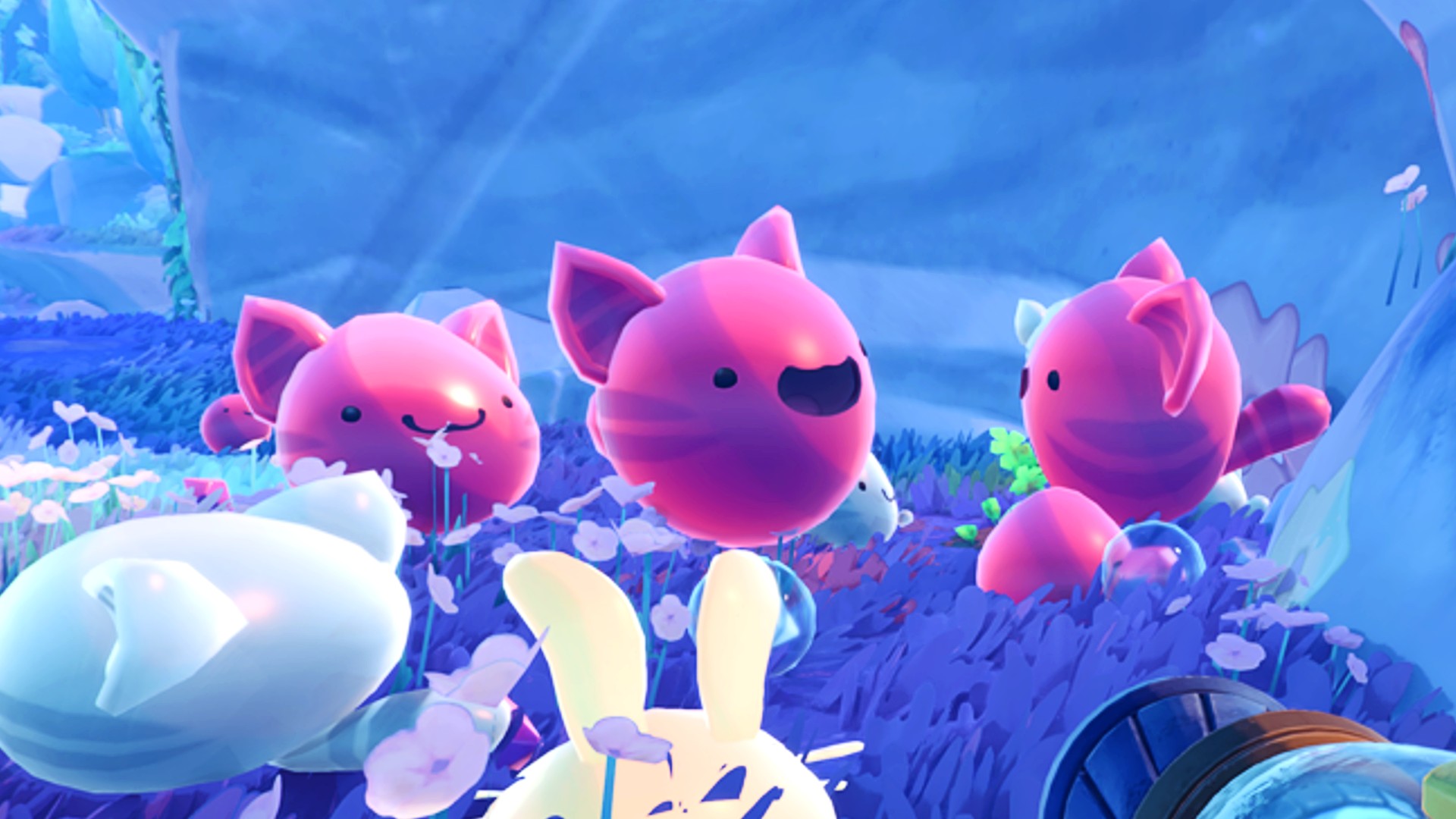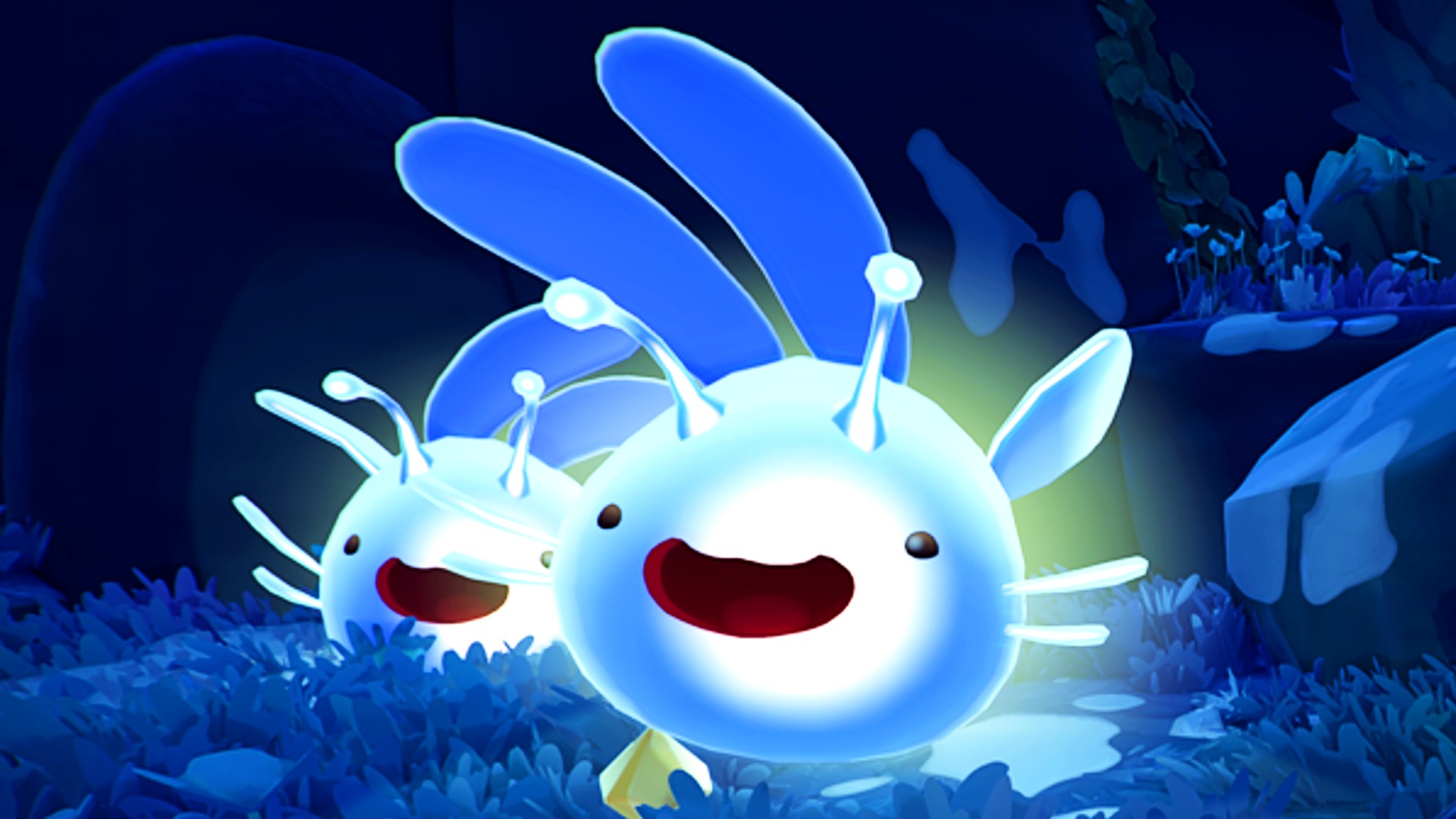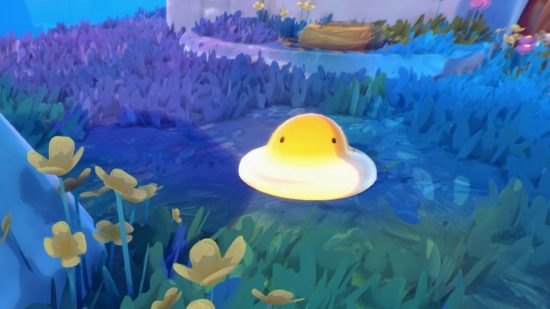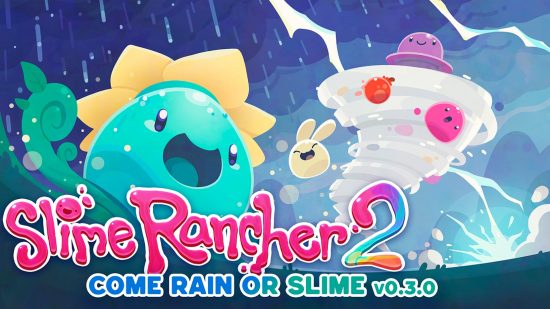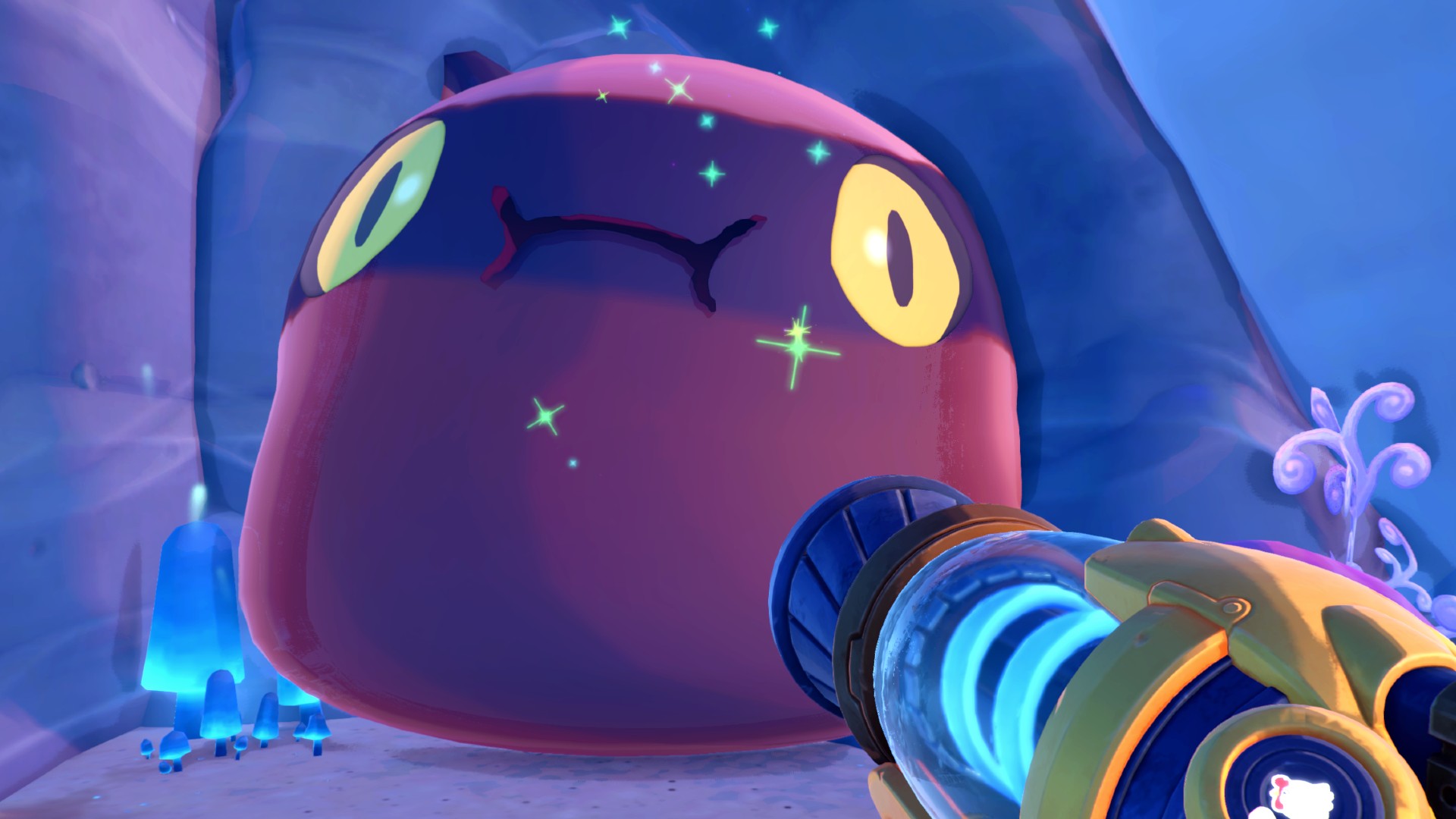There are a lot of Slime Rancher 2 slimes to get to know, with new slime variants joining returning favorites in the colorful farming sim. There’s a lot to know about all of them, including what they eat, where they can be found, and how much you can earn from their plorts as you seek to explore this mysterious new land.
Of course, in a game called Slime Rancher, the most important thing is wrangling slime. Yes, there are other aspects to the simulation game: the gorgeous map, important research, and exciting inventions, but before any of that, you need to know about Rainbow Island’s blobby residents. It’s your job, after all. Rarer slimes produce more valuable plorts, thus earning you more Newbucks to help with upgrading the conservatory and so on, so here’s every Slime Rancher 2 slime and what you need to know about them.
New Slime Rancher 2 slimes:
- Angler Slime
- Batty Slime
- Cotton Slime
- Flutter Slime
- Ringtail Slime
- Saber Slime
- Yolky Slime
Returning Slime Rancher slimes:
- Boom Slime
- Crystal Slime
- Dervish Slime
- Fire Slime
- Honey Slime
- Hunter Slime
- Phosphor Slime
- Pink Slime
- Puddle Slime
- Rock Slime
- Tabby Slime
- Tangle Slime
- Lucky Slime
- Gold Slime
- Largo Slimes
- Feral Slime
- Tarr Slime
- Gordo Slimes
Pink Slime
- Found: Everywhere
- Diet: Fruit, Veggies, Meat
- Favorite food: None
The most familiar slime, and the most common, pink slimes can be found as soon as you sail onto Rainbow Island, and there are likely a few hanging around the Conservatory most of the time. While it’s good to start with a few Pink slimes on your farm in the early days, their plorts are the least valuable, so the only real benefit to keeping them or creating pink Largos is that their varied diet makes it pretty easy to keep them happy and well-fed.
Tabby Slime
- Found: Rainbow Fields, Ember Valley
- Diet: Meat
- Favorite food: Stony hen
Tabby slimes are back from the original Slime Rancher, as these adorable kitties were always a fan-fave. As meat eaters, they can be quite difficult to keep fed unless you have an active chicken coop, so your best bet is to combine some Tabbies with Pink or Cotton slimes to add to their dietary choices.
Tabbies are also very common, and can be found as early as Rainbow Fields.
Cotton Slime
- Found: Rainbow Fields, Ember Valley, Starlight Strand
- Diet: Veggies
- Favorite food: Water Lettuce
These rampant rabbits are new to Slime Rancher 2 and appear in the very early stages of the game in Rainbow Fields. You don’t need to unlock any locations to find them, and as their plorts are more valuable than those of pink slimes, they are a great variant to bring back to the Conservatory asap. And they’re just really, really cute.
Phosphor Slime
- Found: Everywhere, only at night
- Diet: Fruit
- Favorite food: Cuberry
Another familiar slime from the first game, the glowing, nocturnal Phosphor slime returns. This slime will only spawn during the night as it cannot survive in daylight, so if you want any back at your farm, you’ll need to venture out in the dark, and make sure you have a fitting corral. Kit their housing out with a solar shield to ensure they don’t disappear when morning rolls around. Not only are their plorts among the more valuable in the early game, but their glowing core makes for some pretty spectacular Largos.
Angler Slime
- Found: Ember Valley, Starlight Strand
- Diet: Meat
- Favorite food: Sea Hen
Surprisingly, the new Angler slime does not need water to live, and unlike the Puddle slime, can be Largo’d. In fact, there’s a lot about this new slime that’s surprising, including the fact that it eats meat. We’ve said it before, but we’ll say it again, consider combining its form with a veggie or fruit eater for easier and more fruitful farming (pun intended). The glowing lure on an Angler slimes head can actually stun its prey – and other slimes.
Rock Slime
- Found: Ember Valley, Starlight Strand
- Diet: Veggies
- Favorite food: Heart Beet
Rock slimes have been brought back for Slime Rancher 2 as one of the few harmful slimes. Unlike Tarr (which we’ll get to further down), Rocks and other such harmful slimes are far more innocent, and are only dangerous due to their playful nature and harsh forms. The rocks protruding from their bodies can cause some damage to Beatrix, but they are still easy enough to vac up and house back at the Conservatory.
Hunter Slime
- Found: Starlight Strand
- Diet: Meat
- Favorite food: Roostro
Of course a slime called the Hunter would be a carnivore. Another fan-favorite from SR1, Hunter slimes are still just as rare and valuable as they ever were. Be careful when you are out in the further reaches of Rainbow Island, as Hunter slime can appear invisible, and their Largo variants always spawn feral. Your best bet to getting a Hunter plort farm going at the ranch is simply to keep an eye out for stray Hunter plorts on the ground, and feed them to another source slime.
Honey Slime
- Found: Starlight Strand
- Diet: Fruit
- Favorite food: Mint Mango
Honey slimes are a very valuable slime for Newbucks collection, as their plorts sell for relatively high values. However, that’s not the only trait Honey plorts boast, as their sweet, saccharine flavour attracts other slimes from a greater distance than usual. Why does this matter? Well, be sure to leave no Honey plorts lying around, or you could soon find the Conservatory plagued by hungry Tarr. We recommend Honey slimes or Largos are kept safely in corrals kitted out with high walls and sky nets. We recommend that for all corrals, but prioritize Honey if you’re short on funds.
Ringtail Slime
- Found: Starlight Strand
- Diet: Anything
- Favorite food: None
There can never be too many adorable animal-themed Slime Rancher slimes, so the Ringtail slime is another welcome addition to Slime Rancher 2. Based on a Tanuki, this brown slime is incredibly unique, and requires special care as it turns to stone in daylight, meaning it will not produce any plorts. Placing it under a solar shield will prevent this behavior, so – if you’re not already sold on the Batty Boom Largo – a Batty Ringtail combination will prevent you having to purchase too many solar shields. Of course there’s always Phosphor to consider as well. Anything but fussy, Ringtail slimes will eat anything – at any time. When they are not hungry, Ringtails will still devour any food around them, but will not produce plorts, so don’t leave any precious resources lying around.
Boom Slime
- Found: Ember Valley
- Diet: Meat
- Favorite food: Briar Hen
Another harmful slime, these poor red and yellow guys can’t help but explode sporadically. Don’t worry, it doesn’t hurt them (as far as we know), but it can hurt you. Like Tabbies, Boom slimes diet consists of only meat, and their favorite food is the somewhat rare Briar Hen, so create Boom Largos with the likes of Rock or Cotton slimes so they’ll like to eat something a little easier to come by.
Crystal Slime
- Found: Ember Valley
- Diet: Veggies
- Favorite food: Odd Onion
These gorgeous, glistening slimes are a real spectacle, so there’s little wonder they’re back for Slime Rancher 2. Like Rock slimes, they are harmful thanks to the sharp crystal formations protruding from their bodies, but they, too, don’t mean it. Just don’t get too close and you’ll be fine. While you’ll want them on all your corrals eventually, prioritize auto-feeders and plort collectors on harmful slime corrals so you can keep your distance.
Batty Slime
- Found: Ember Valley
- Diet: Fruit
- Favorite food: Pomegranate
Another new discovery on Rainbow Island, Batty slimes have unique characteristics. While they can survive in the daylight, it agitates them, so you might want to keep them under solar shields. And, of course, a sky net. According to discussions in the official Slime Rancher discord, the favorite Batty Largo is a Batty Boom, if nothing else than just for the name.
Fire Slime
- Found: Ember Valley
- Diet: Ash
- Favorite food: None
Like Puddle slimes, Fire slimes require a specific environment, and must be housed in the ash tray of an incinerator or they despawn. An incinerator is always useful to have in the Conservatory though, as you can get rid of any unnecessary items (or, um, slimes) there. To feed a Fire slime, you first need to ‘cook’ any other food item to turn it to ash. Of course, Fire slime can be harmful, not just to you, but to other slimes.
Puddle Slime
- Found: Starlight Strand
- Diet: Water
- Favorite food: None
We’re not yet sure whether Slime Rancher 2’s secret styles are the same as SR1, but if they are, Puddle slimes are among the best. But even before you’ve unlocked the watery slime’s alternative look, it’s a great slime to have, if nothing else than to give a different feel to your farm. Instead of corrals, Puddle slimes must of course be housed in a pond if they are to survive, but they don’t need feeding as they live off the very water they float in. This makes them a great slime to have automatically churning out plorts – especially since they can be fairly valuable.
Puddle slimes, like in Slime Rancher, cannot be turned into Largos as they don’t eat plorts, nor can their plorts be consumed.
Flutter Slime
- Found: Starlight Strand
- Diet: Nectar
- Favorite food: Moondew Nectar
This new slime is based on a butterfly, and can make for quite the stunning Largo depending on which other source slime with which you combine it. It can be hard to keep a Flutter slime happy as their food is quite rare, so you might want to consider combining it with something you can easily feed. Of course you’ll also want a sky net on its corral, due to, you know, it having wings and all.
Saber Slime
- Found: Powderfall Bluffs
- Diet: Meat
- Favorite food: Thundercluck Chickens
These adorable prehistoric slimes were in Slime Rancher the first, but they could only ever be found in their largo form. In Slime Rancher 2, Bea LeBeau has discovered the original hunting ground of the Saber slimes, Powderfall Bluffs, as an icy time capsule has defrosted bringing the ancient sites and creatures within it back to life. That means we can discover base Saber slimes for the first time, as well as their favorite food, the ever-so-cool Thundercluck chickens.
Yolky Slime
- Found: Everywhere
- Diet: None
- Favorite food: None
While Yolky slimes can be found in every biome of the Rainbow Island map, they can’t technically be found everywhere, as they will only pop out of hen nests – and very sporadically, at that. These cute egg slimes aren’t only rare, but they also have a very unique mechanic. Pop a Yolky slime in a chicken coop, with plenty of roostros, hens, and space, and those hens may just lay a giant egg, within which will be bonus chicks and even Yolky plorts if you’re break the egg quick enough. Due to their nature, Yolky slimes can’t become largos.
Dervish Slime
Found: Near cyclones
Diet: Fruit
Favorite food: Prickly Pear
The fan-favorite but destructive Dervish slime returned to Slime Rancher 2 with the Come Rain or Slime update in November, 2023. Rather than being found in a hidden area like in Slime Rancher, the tornado slime is now found during one of the update’s new weather events – cyclones. During a storm, stick close to any cyclone you see (but a safe distance, of course), and you should come across one or two of these naughty slimes. Be careful keeping that back at your ranch though, when Dervishes get hungry, they kick up a storm.
Tangle Slime
Found: Anywhere, during a Level 3 pollen storm
Diet: Meat
Favorite food: Painted hen
Another Slime Rancher favorite, the Tangle Slime, also returned with the Slime Rancher 2 weather update. Tangle slimes only appear during a pollen storm, so take some hayfever medication and get out there. Painted slimes came back with the update too, as they’re the Tangle slime’s favorite food.
Lucky Slime
- Found: Anywhere, rare spawn
- Diet: Meat
- Favorite food: None
Lucky slimes spawn very sporadically and have the appearance of a Chinese maneki-neko, or lucky cat, and you’ll know when one is nearby from a tinkling bell sound. By feeding a Lucky Slime any meat item, you will be rewarded with some Newbucks, but they don’t stick around for long and despawn quickly, so whenever you’ve got a spare slot in your vac, keep a Hen Hen in there just in case.
Gold Slime
- Found: Anywhere, very rare spawn
- Diet: Plorts, any food, chickadoos
- Favorite food: None
Like Lucky Slimes, Gold Slimes appear randomly and don’t hang around. They work in exactly the same way as Lucky Slimes, in fact, only they eat pretty much anything put in front of them. Instead of Newbucks, you’ll be rewarded with a Gold Plort, which is the most valuable by far, and cannot be fed to another slime. Since this slime is so valuable, it is incredibly rare – more so than Lucky slimes. You’ll know there is one nearby is you hear a magical, prolonged twinkling sound.
Largo Slime
- Found: Anywhere
- Diet: Same as source slimes
- Favorite food: Same as source slimes
A Largo slime is the umbrella term for any slime that has been created from two source slimes. These are actually the best way to farm plorts, as housing them requires fewer corrals, and their favorite food options increase, making it easier to gather the maximum number of plorts. When one slime eats the plort of another slime, it will take on the combined form of the two. For example, feeding a Cotton slime a Boom plort will create a Cotton/Boom hybrid slime and it will double in size. Too big to be sucked into your vac, Largo slimes can instead be carried on the end of the device due to the suction, if you need to move one to another area.
As with their source slimes, feed a Largo slime either of its source’s favorite foods and it will produce double the plorts for a total of four – two of each source slime.
Feral Slime
- Found: Anywhere
- Diet: Same as source slimes
- Favorite food: Same as source slimes
Feral slimes are really just hungry Largos. If you ignore a slime for long enough, it will – understandably – become so upset it becomes feral and turns hostile, and will attack you, doing slight damage. Feral slimes can both appear in the wild and back at the Conservatory if you’re away long enough, but can be returned to normal with a snack.
There is an option to disable Feral slimes in the gameplay options menu.
Tarr
- Found: Anywhere
- Diet: Other slimes!
Tarr slimes are, for all intents and purposes, Slime Rancher’s only “danger”. Formed when a largo eats a third plort type that does not match its type, Tarr slimes change form and become hostile, eating every other slime in sight and injuring you if it gets close enough. Make sure you do not allow slimes to roam ‘free range’ in the conservatory, as this will inevitably result in a Tarr takeover. However, there’s little you can do to prevent them in the wild.
In the early game, Tarr slimes can be defeated by picking them up on the end of your vac and shooting them into the ocean. However, this is time consuming and a little dangerous, so upgrade your vac to include a water tank ASAP, as shooting water at a Tarr will cause it to despawn.
Finally, Tarr slimes can be turned off in the gameplay options menu at any time.
Gordo Slime
- Found: Multiple locations
- Diet: Same as source slime
- Favorite food: Same as source slime
Similar to Largo slimes, Gordo slimes vary in type, and their favorite food matches that of their source slime. However, Gordo slimes are even bigger and don’t move, each one located in a specific part of the map. Gordos have a hefty appetite, and eat until they burst. While this sounds horrible, it is actually your goal, and their purpose in life. Fill a Gordo with 60 food items (or as little as 30 if you feed it its favorite), and it will separate into smaller, standard versions of that slime – and some other bonus rewards, too.
With that information in mind, you can set about filling your corrals with each of your favorite Slime Rancher 2 slimes and whichever Largo combinations you set your heart on. And while the farming game may not be co-op, rest assured you are not alone on Rainbow Island, as Monomi Park are left “staggered” by sales and the masses of “overwhelmingly positive” Steam reviews.


